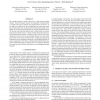Free Online Productivity Tools
i2Speak
i2Symbol
i2OCR
iTex2Img
iWeb2Print
iWeb2Shot
i2Type
iPdf2Split
iPdf2Merge
i2Bopomofo
i2Arabic
i2Style
i2Image
i2PDF
iLatex2Rtf
Sci2ools
ICMCS
2006
IEEE
2006
IEEE
Receiver-Based Optimization for Video Delivery Over Wireless Links
We consider transfer of video frames over a time-varying wireless channel. When the channel is good, the transmitter can send frames at a higher rate than the receiver can consume them via playout. In that case, we introduce the idea of admitting new frames even when the receiver buffer is full, by selectively evicting frames already in the buffer; we can also control the playout rate, so as to optimize the tradeoff between video distortion and the time to freeze when the channel turns bad and frames arrive at a lower rate than should be played out. The decision/control problem of whether to admit a new frame, which already stored one to evict to accommodate the new one, and at what rate to play out frames is formulated within a dynamic programming framework, and an interesting connection to the Knapsack problem is made. Application of the idea in a relevant simple system shows significant performance gains, indicating that it is a promising approach for improving video delivery perf...
| Added | 11 Jun 2010 |
| Updated | 11 Jun 2010 |
| Type | Conference |
| Year | 2006 |
| Where | ICMCS |
| Authors | Carri W. Chan, John G. Apostolopoulos, Yan Li, Nicholas Bambos |
Comments (0)

